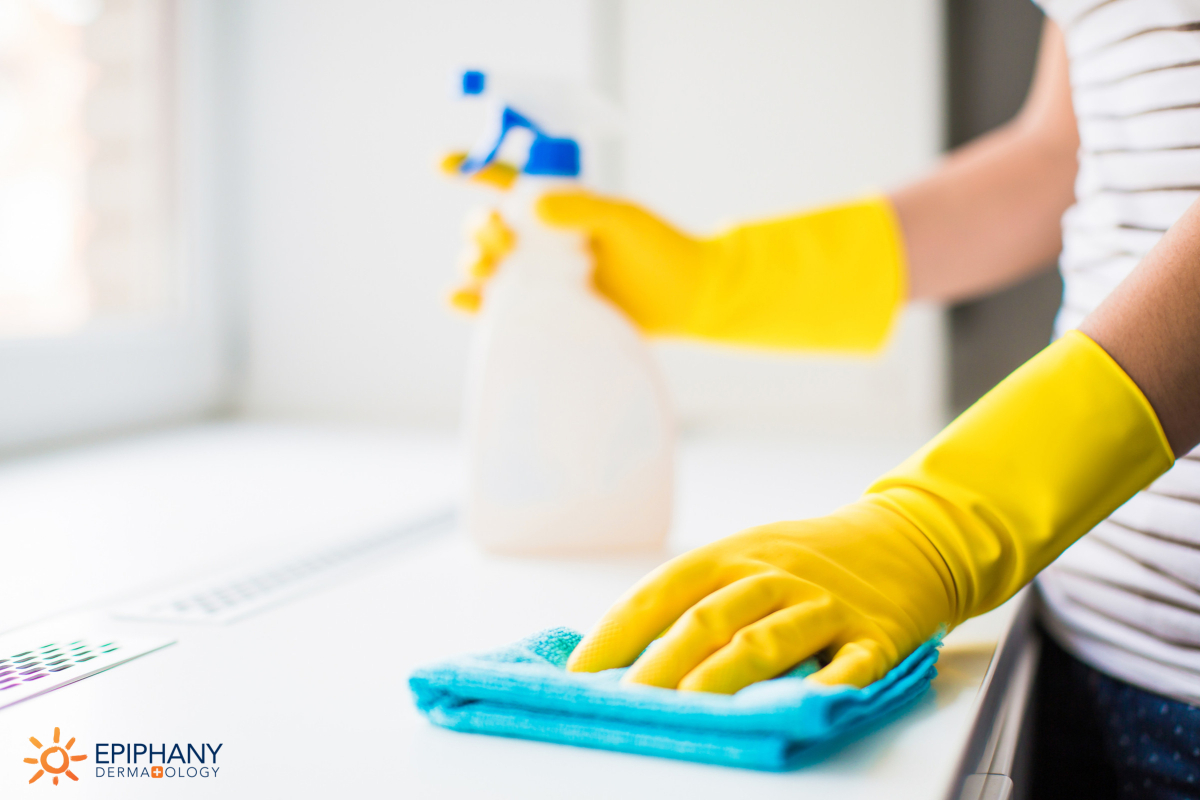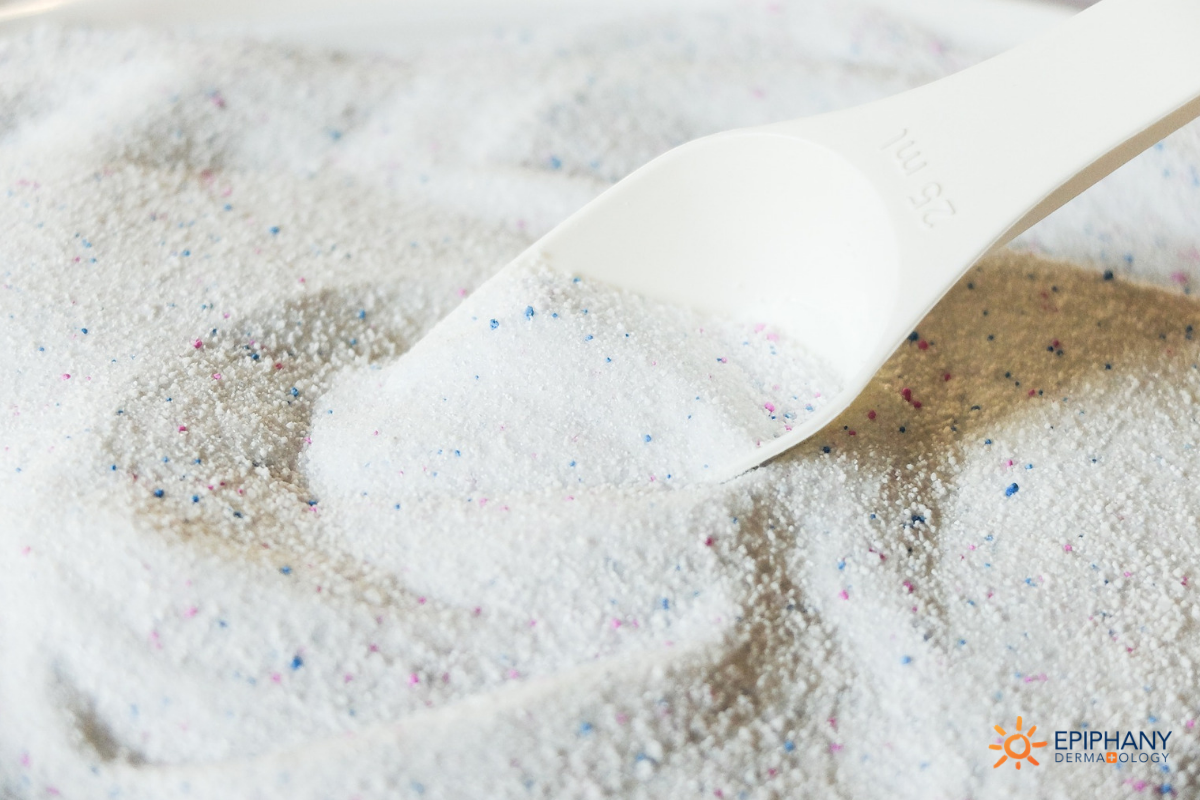It’s great to have a clean house. We love the scent of fresh laundry and the shine of a clean countertop.
What’s not great? Getting a skin rash from cleaning products (or other items) you use daily.
If you’ve noticed some skin irritations, a household product may be its cause. For many of these issues, there’s a simple fix. Here’s what you need to know:
Allergic vs. Irritant Contact Dermatitis
First, figure out what kind of reaction you’re having. Most household products result in skin irritations, not allergic reactions. Allergic contact dermatitis comes from a specific allergy to a substance — like a peanut allergy or a reaction to poison ivy.
Most people who experience contact dermatitis aren’t dealing with an allergy to their household products — they’re dealing with a skin rash we call irritant contact dermatitis.
Irritant contact dermatitis comes from exposure to a product that could irritate anyone’s skin. You’re not specifically allergic to it, but because of the harsh chemicals, it strips the oils away and leaves your skin red, inflamed, itchy, and generally uncomfortable.
What’s Making Your Skin Break Out?
Your skin can get irritated for a multitude of reasons, so we need to find the source.
Is something making your hands red and rashy or causing your waistline to itch? It’s likely one of these products:
Soap
Soap is one of the most common culprits of irritated skin. Many of us wash our hands too much. Yes, washing your hands is the number one way to prevent disease, but your hands aren’t always contaminated. If they’re not (for example when chopping vegetables), rinse them with water instead of scrubbing them with soap.
Obsessive hand-washing actually works against you. It strips your skin of the natural oils and moisture it needs to protect itself. Of course, if your hands are dirty or you just went to the restroom, use soap… but opt for a gentle cleanser.
Replace your household soaps with mild hydrating cleansers. Choose products like Cetaphil or CereVe hydrating cleansers to clean your hands without stripping the oils.
Also, try to avoid industrial soaps. The soaps provided in hospitals, restaurants, and retail stores are extremely hard on your skin. If you’re regularly washing your hands at work with these industrial cleaners, you’re likely irritating your skin. Instead, bring a travel-sized hydrating cleanser with you to use while you’re away from home.
Household Cleaners
Consider what household cleaners you’re using as well. Household cleaners often contain chemicals that work well for their purpose but work against your skin.
There’s a simple fix — gloves! Wearing gloves is an easy way to prevent a skin rash from cleaning products.
Put on your gloves to protect your skin when you’re using the following products:
- Dish detergent
- Laundry detergent
- Furniture polish
- Drain cleaners
- Toilet disinfectants
Fabric and Latex
Both clothing material and fabric softeners can cause irritant dermatitis. If you have a rash in areas covered by your skin, clothing is a likely source of the problem.
Rough fabrics like wool can irritate the skin for people who have eczema. Sometimes certain dyes for synthetic fabrics cause irritation as well. Cotton is usually the safest clothing material if you’re having a reaction.
Also, skip the fabric softener. Many fabric softeners and dryer sheets cause irritation.
Think you may have a skin allergy? Check your products for latex. Latex is a very common skin allergy and can be found in everything from gloves to condoms to your elastic waistbands and bra straps. If these seem to be causing a reaction, switch to latex-free products.
Fragrances, Facial Creams, Lotions
Many people are sensitive to the chemicals used to preserve fragrances… and many fragrances are added to cosmetic creams and lotions. You may also have a sensitivity to creams containing different types of acid (glycolic, lactic, or ascorbic) or retinol.
If you’re reacting to these ingredients, switch to a more hypoallergenic product that doesn’t contain retinol, fragrance, or any type of acid.
Food
You don’t have to be allergic to a food for it to irritate your skin. Many people have skin irritations that come from preparing food. You may notice that a skin rash forms after preparing acidic or spicy foods.
For example, if you squirt lime juice on your hand and expose it to sunlight, it can cause a brown discoloration on the skin. People tend to notice this type of food reactions particularly in the summer or after outdoor meals.
Jewelry
Check your jewelry to see if it contains nickel. Nickel is a very common irritant, but it’s also a commonly used metal in earrings and other types of jewelry, particularly less expensive jewelry.
Opt for nickel-free accessories if you notice that you’re reacting to your earrings, necklaces, rings, or bracelets.
Sunscreen
Dermatologists love sunscreen. But even sunscreen contains chemicals that can cause a reaction for some. If your sunscreen seems to cause your skin to react adversely, choose chemical-free (or PABA-free) sunscreens to incorporate into your daily skin care regimen.
Our skin can react to chemicals, materials, foods, and metals. It’s not possible to avoid every potential skin irritant, but awareness goes a long way. Once you narrow the possibilities of what may be causing your contact dermatitis, you’ll likely find that a few small changes bring major results in improving your skin’s health.

Mary Gurney, PA-C is a board-certified physician assistant in Denton and Frisco, TX. An active member of the Texas Academy of Physician Assistants and the Society of Dermatology Physician Assistants, Mary has a passion for medical and cosmetic dermatology and has practiced medicine for over 10 years in the DFW area. In her spare time, she enjoys watching movies, reading, hiking, checking out new restaurants in town, and spending time with her family.
Learn more about Mary Gurney.


